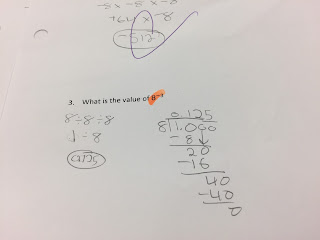Regular Math Standard: 8.EE.1 Know and apply the properties of integer exponents to generate equivalent numerical expressions.
Regular Math Lesson Sequence:
- Which One Doesn't Belong (1, 9, 36, and 45)
- Logged into Chromebook and did a TenMarks rounding decimals lesson
- Had four students do problems from the homework on the board
- Did a quick exponent power of a power exploration (which I skipped in one class due to time constraints)
- Exit Ticket. This consisted of three things. First, rewrite (5^2)^4 in expanded form. Second take that same expression and put it into exponential form. Third, rewrite the expression 7^6/7^3 and then write it in standard form.
Only one class needed to be prompted to bring up the perfect squares and rational numbers with Which One Doesn't Belong. It was refreshing to hear students also talk about composite numbers and divisibility.
Some students really struggled with rounding on the computer. I was not surprised given how difficult it can be to do problems on computers and given what I know from teaching sixth grade surrounding place value and rounding. My colleague and I discussed how there is just too much on the plate for these students in math now. I can only remember working on the operations, fractions, and place value when I was in elementary school. Today there is so much more that they have to know and as a result their mastery of what I would perceive to be the basics is no longer a guarantee.
The power of a power exercise was good once my co-teacher told me to write (3^2)^4 as 3^2 x 3^2 x 3^2 s 3^2. I was initially writing out three eight times to explain this to kids. The tickets to leave were pretty on target. As the pictures below illustrate some students made errors in putting the exponent (one student used 6 and another used 9) on problem two, but overall they are seeing the big picture.
Honors Math Objective: Solve addition and subtraction inequalities
Honors Math Standard: A1-REI-D12 Graph the solutions of a linear inequality in two variables as a half-plane (excluding the boundary in the case of a strict inequality), and graph the solution set of a system of linear inequalities in two variables as the intersection of the corresponding half-planes.
Honors Math Lesson Sequence:
- Which One Doesn't Belong (x squared, 4 - 2y, x - 1, and 3 (x + 1)
- Login to TenMarks and complete the work on rounding decimals
- Review the homework
- Exit Ticket on inequalities
There was a great question about an absolute value equation in the form of c |x - 4| + d = e where a student asked if we could divide by c before subtracting by d on the homework. We went through what could be done in this scenario to make sure that c/d was a fraction if you did divide by c. I honestly had never really considered doing the division as I had been trained away from this at a young age and never thought to question it. It was enlightening for me to learn too.
The which one doesn't belong is a great conversation about what it means to simplify because students could argue that 4 - 2y can be simplified and so can 3 (x + 1).
The exit ticket went pretty well for the most part. From what I can tell students know what they are doing with the inequalities. It is subtracting by a negative or subtracting from a negative that threw them off if anything threw them off. Only one student left the dot open when graphing.





















































